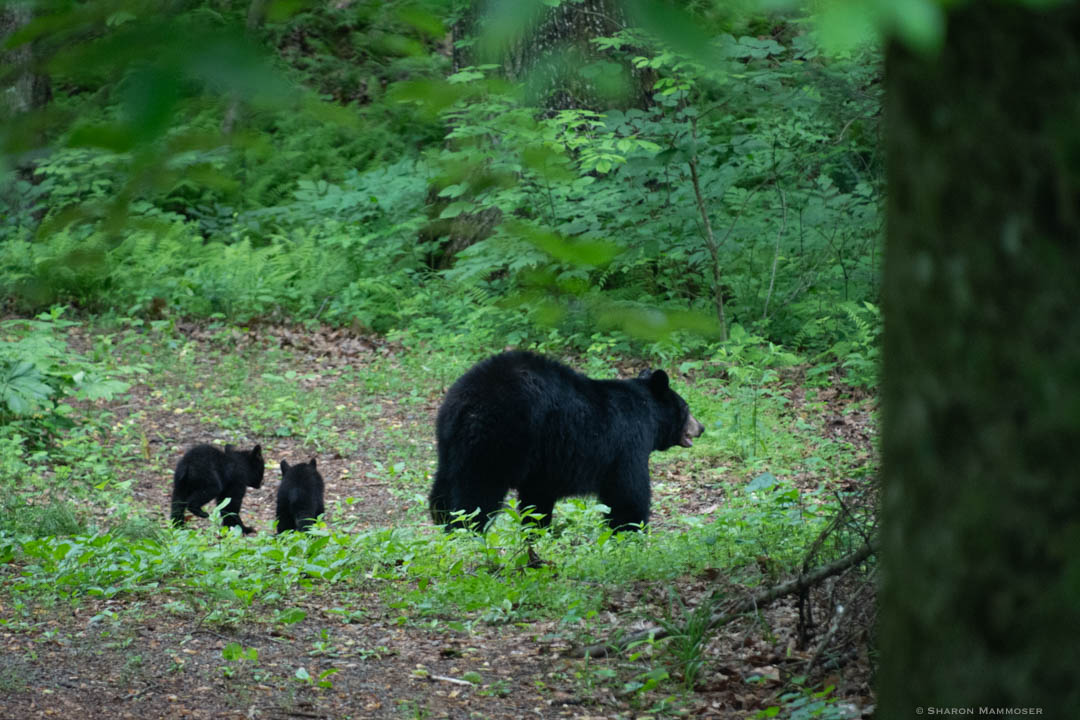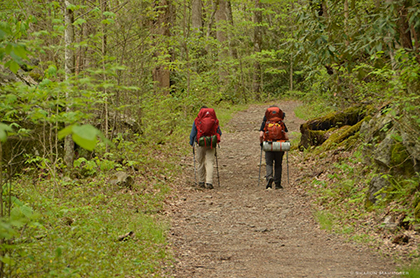Learning to Hike Where Black Bears Live

By Naturalist and Photographer Sharon Mammoser.
Someone recently wrote to the local paper in Asheville, asking for hiking suggestions where she could be guaranteed NOT to encounter bears. Since western NC is home to approximately 8000 black bears, it’s impossible to find a bear-free place.
Black bears have a natural fear of humans and generally avoid us. Their sense of smell is so much better than ours that they usually disappear long before we ever get to see them, and if we do see them, it is usually their butts as they hurry away. Did you know bears smell 10x better than a bloodhound?
The solution then is to overcome our fear of bears and try instead to embrace the opportunity to witness a wild animal in its natural habitat—something many visitors to our area strive to experience. Maybe try to look at it from a bear’s point of view— they are just as reluctant to run into humans and only want to be left alone.

Here are a few tips to help keep you and your pets safe:
Always keep your dog on a leash. The National Parks forbid dogs on almost all of their trails because no matter how obedient or loyal you think your dog is, you never can know with certainty what it will do when faced with a wild animal. Dogs may chase and even kill fawns and other animals. They may confront bears, increasing risk of injury or even death. The dog is simply acting on instinct. Humans can act on wisdom and kindness, knowing responsible choices come with being a pet owner.
Never allow your dog to bark at, chase, harass or corner a bear (or other wildlife.) If you don’t think you’ll be able to stop your dog from barking at wildlife, consider leaving your dog home. Wild animals are unpredictable. You don’t know what any animal will do when feeling threatened.
Stay alert. Pay attention to your surroundings. Limit distractions like headphones and phones. Be present. There is so much to see if you are in the moment and in doing so you won’t be suddenly surprised by a quiet bear on the trail.
Keep a safe distance from wildlife and never try to get closer for a better photo. Give bears space! Back away slowly if you happen to come upon a bear and it notices you. If the bear knows you are there and changes its behavior, you are too close.
If a bear is aware of your presence and is moving towards you, wave your hands over your head, make noise, try to appear larger. Clap your hands and yell to make it clear to the bear that you are a human. Wild bears almost always run away from humans.
Don’t allow your kids to run ahead where you can’t see them and have a conversation with them about what to do if they see a bear.
Never run from a bear. Running may trigger a predatory response in the bear, causing it to chase you. No matter how fast you are, you’re not faster than a bear, as they can sprint 35 miles per hour.
If it will make you feel safer, carry bear spray. Keep it handy and learn how to use it. Bear spray is highly effective when used correctly to deter a rare problem bear.
If you are eating during your time hiking, always leave no trace. This means picking up any crumbs or pieces of food you may have dropped and don’t leave trash behind. These scraps may seem harmless but attracting wild animals to an area for a food reward is a bad idea. Future hikers may pay the consequences.
If nature calls and you have to go to the bathroom while hiking, either carry your toilet paper out with you, use leaves or natural materials, or don’t use toilet paper at all. Human waste and toilet paper may attract bears. Not surprisingly, tampons, feces, and toilet paper are harmful to a bear’s digestive system. Good choices keep bears healthy.
Bears are amazing animals, and deserving of our respect. They are here to stay so we need to learn how to coexist. Let’s appreciate them from a distance and remember we are visitors to their space. We can all do our part to keep them safe, and wild.
Related: Living with Bears – Some Tips to Coexist Peacefully